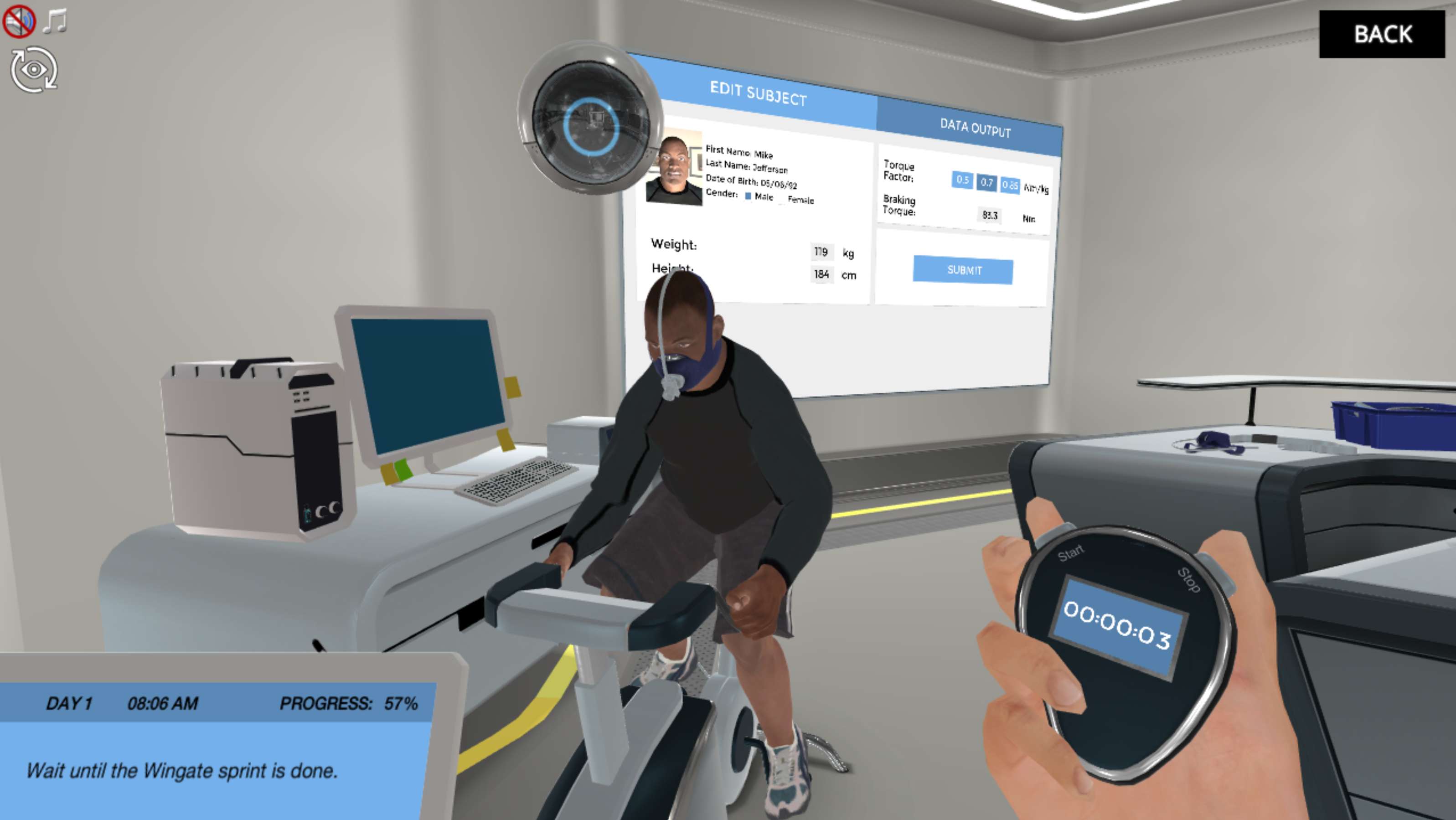Heading 1
Heading 2
Heading 3
Heading 4
Heading 5
Heading 6
Lorem ipsum dolor sit amet, consectetur adipiscing elit, sed do eiusmod tempor incididunt ut labore et dolore magna aliqua. Ut enim ad minim veniam, quis nostrud exercitation ullamco laboris nisi ut aliquip ex ea commodo consequat. Duis aute irure dolor in reprehenderit in voluptate velit esse cillum dolore eu fugiat nulla pariatur.
Block quote
Ordered list
- Item 1
- Item 2
- Item 3
Unordered list
- Item A
- Item B
- Item C
Bold text
Emphasis
Superscript
Subscript
About This Simulation
In this sports science lab, you will find out how only three times ten minutes of supramaximal sprint interval training per week can increase your exercise capacity and fitness level.
Learning Objectives
- Explain physiological responses to high-intensity sprint interval training (SIT)
- Understand how to perform a Wingate sprint
- Determine the impact of repeated Wingate sprints on health
- Monitor acute and chronic physiological responses during and after a Wingate sprint
- Explain the contribution of different energy systems during supramaximal exercise
- Perform a breath-by-breath gas analysis
- Define the role of lactate in anaerobic glycolysis
- Measure blood lactate levels
About This Simulation
Lab Techniques
- Blood lactate assay
- Wingate sprint
- Respiratory exchange ratio (RER) measurement
Related Standards
- 11.2 Movement
Learn More About This Simulation
In the Exercise Physiology simulation, you will supervise a clinical trial to investigate the acute and chronic physiological effects of high-intensity sprint interval training (SIT) on a sedentary lifestyle.
Perform an anaerobic exercise
You will learn how this type of anaerobic exercise, also called the Wingate sprint, is connected to the body’s ancient “fight-or-flight” response and how to monitor this process in the lab. Your task is to follow a training program consisting of brief repeated cycle sprints over four weeks with one of the study participants. You will then determine the effect of the Wingate protocol on the participant’s health and fitness.
Monitor the physiological response
At the beginning of the Exercise Physiology simulation, you will learn how to set up the necessary equipment and choose the correct settings to correctly perform a Wingate sprint. During the sprint, you measure power output, respiratory exchange ratio, and the heart rate of the study participant to determine the physiological effects during the course of the interval training. You will simultaneously be able to study the skeletal muscles and to observe how the energy during the sprint is produced at a molecular level. You will also be able to observe the effects of this on the pulmonary and cardiovascular system. By measuring the participant’s blood lactate levels before and after the sprint, you will learn about the role of lactate in anaerobic glycolysis.
The effect of repeated Wingate sprints on a sedentary lifestyle
By analyzing all the data collected during the study, you will be able to come to a conclusion about the specific effect of the Wingate interval protocol.
Will this 20-seconds-sprint training have a significant effect on the health of sedentary individuals?
For Science Programs Providing a Learning Advantage
Boost STEM Pass Rates
Boost Learning with Fun
75% of students show high engagement and improved grades with Labster
Discover Simulations That Match Your Syllabus
Easily bolster your learning objectives with relevant, interactive content
Place Students in the Shoes of Real Scientists
Practice a lab procedure or visualize theory through narrative-driven scenarios


FAQs
Find answers to frequently asked questions.
Heading 1
Heading 2
Heading 3
Heading 4
Heading 5
Heading 6
Lorem ipsum dolor sit amet, consectetur adipiscing elit, sed do eiusmod tempor incididunt ut labore et dolore magna aliqua. Ut enim ad minim veniam, quis nostrud exercitation ullamco laboris nisi ut aliquip ex ea commodo consequat. Duis aute irure dolor in reprehenderit in voluptate velit esse cillum dolore eu fugiat nulla pariatur.
Block quote
Ordered list
- Item 1
- Item 2
- Item 3
Unordered list
- Item A
- Item B
- Item C
Bold text
Emphasis
Superscript
Subscript
A Labster virtual lab is an interactive, multimedia assignment that students access right from their computers. Many Labster virtual labs prepare students for success in college by introducing foundational knowledge using multimedia visualizations that make it easier to understand complex concepts. Other Labster virtual labs prepare learners for careers in STEM labs by giving them realistic practice on lab techniques and procedures.
Labster’s virtual lab simulations are created by scientists and designed to maximize engagement and interactivity. Unlike watching a video or reading a textbook, Labster virtual labs are interactive. To make progress, students must think critically and solve a real-world problem. We believe that learning by doing makes STEM stick.
Yes, Labster is compatible with all major LMS (Learning Management Systems) including Blackboard, Canvas, D2L, Moodle, and many others. Students can access Labster like any other assignment. If your institution does not choose an LMS integration, students will log into Labster’s Course Manager once they have an account created. Your institution will decide which is the best access method.
Labster is available for purchase by instructors, faculty, and administrators at education institutions. Purchasing our starter package, Labster Explorer, can be done using a credit card if you are located in the USA, Canada, or Mexico. If you are outside of North America or are choosing a higher plan, please speak with a Labster sales representative. Compare plans.
Labster supports a wide range of STEM courses at the high school, college, and university level across fields in biology, chemistry, physics, and health sciences. You can identify topics for your courses by searching our Content Catalog.















